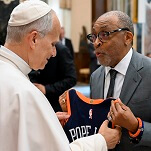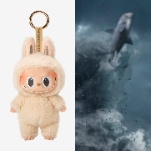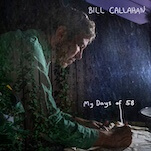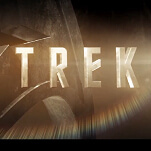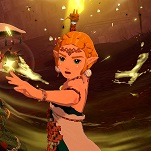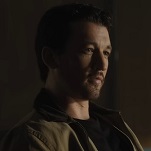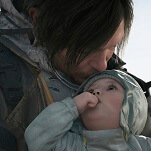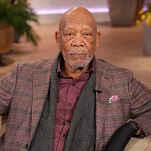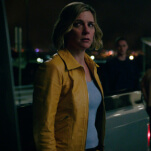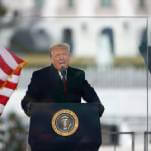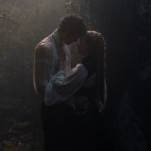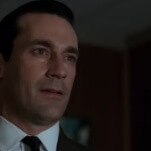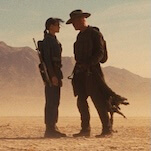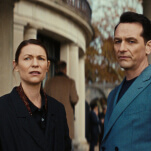“Like the others, you were strong and swift and brave, a natural leader. But you had something they didn’t. Something no one saw but me. Can you guess? Luck. Was I wrong?”
Luck is often less a matter of odds than it looks; luck is made by circumstance and context. Whether or not something is lucky depends on what parts of the story we choose to tell. Where one person sees luck, another might see all the work that someone else did to create that opportunity in the first place. The Master Chief Collection, a recently released bundle of the numbered Halo games for Xbox One, shows the need for that sort of perspective. It retells the story of the Halo series in a way that leaves out some of its key parts, focusing on the Master Chief and his games to the detriment of the characters that made him what he is.
The Collection’s Halo is the story of a lone warrior, a bio-mechanically enhanced graduate of the United Nation Space Command’s super-soldier program who wages a war against vast alien hordes and saves the human race (and then saves it again… and again… and also a fourth time), accompanied by a handful of readily killable supporting characters and the AI lady in his head. It’s an individualistic story, the tale of one gruff hero versus the world, the sort of messianic champion who can turn the tide of a battle just by bothering to clock in.
Likewise, the games industry story of the numbered games in the Halo series is that of uncontroversial greatness, one best-selling release after another, each one showing noticeable strides forward and earning showers of praise. But Halo: Reach and Halo 3: ODST, two Halo side stories not included in the collection, complicate and recontextualize both the in-game and real-world Halo narratives. Without their inclusion, The Master Chief Collection feels like a revisionist history, a telling of the story that conveniently leaves out chapters that might be unobtrusive but are nonetheless essential.
ODST, which Microsoft is readying for a post-launch addition to The Collection as a downloadable add-on, casts players as The Rookie, a member of an elite special ops unit embroiled in an essential intelligence-gathering mission that directly leads into Halo 3. Unlike the Master Chief, The Rookie is fully human, a slightly tougher version of the normal marines that tend to get murdered by the spaceship-load in the main Halo games. This change in perspective casts the Halo world in a new light. Here, players play as someone small and flimsy, a normal guy facing down alien hordes that eclipse you in size, strength, and number. ODST forces you to do things you’ve never done before in a Halo game. You run away. You hide. Some missions end with you desperately retreating from collapsing lines, closing the doors and erecting barriers as the Covenant menace slams against them, bent on your blood. Yet despite your weakness, you play a crucial role in the story, putting the Master Chief’s Halo 3 mission in motion and making the armies he faces seem more threatening than ever. We get to see that our favorite lone Spartan doesn’t succeed because of his own greatness; his success is dependent on missions like this one, where normal people fight against monsters they’re not sure they can defeat.
Later, Halo: Reach posited that the Chief’s successes also resulted from the sacrifices of other super soldiers who weren’t as lucky as he is. A prequel to the first Halo, Reach reworks the towering victories of the main games as tragedy, with all of the barn-burning heroics ending in grievous losses. As our own Drew Toal wrote, Reach’s ragtag group of Master Chief prototypes are doomed heroes “with no sequels and no happy ending, the stuff of songs and stories.” And like the soldiers of ODST, the Spartans who star in Reach are instrumental in the Chief’s later successes, hand delivering Cortana to the spaceship where the Chief will collect her and begin his journey in Halo: Combat Evolved.
ODST and Reach add much-needed context to the Master Chief’s story, spotlighting the collective successes and sacrifices that were necessary for the legendary hero to become legendary in the first place. The Master Chief is lucky because the work and sacrifice of unsung heroes allowed him to be. What’s more, these side stories inject much-needed humanity and tragedy into Halo’s world, giving us flawed and failing heroes, members of a human race recognizably on the brink of annihilation. Their presence makes every Halo game a better one, and they make the Master Chief a better hero, less a force of nature and more the favored son, a product of the scores of other soldiers, super and otherwise, who paved a way for him. The Chief is no Messiah. He’s just the one that lived.
And neither ODST nor Reach ascended to the popularity of the main Halo games. Despite being nuanced additions and critical and commercial successes, neither had the staying power of the numbered entries. The later days of Bungie’s tenure over Halo—before 343 Industries took over with Halo 4—were marred by a Halo fatigue, and while interesting, neither game was positioned to offer anything revolutionary. Reach and ODST are underdog games starring underdog heroes, overshadowed by their bigger, more glamorous brethren.
What these games reveal about the Master Chief is also true for the series in which he stars. Halo was lucky. Like the Master Chief himself, the series’ success benefited from circumstance as much as its own excellence. The original game and Halo 2, to an extent, were positioned at just the right place in the history of the Xbox—and first-person shooters in general—to succeed. ODST and Reach—polished, experimental, and smart as they were—could not benefit from being in the right place at the right time. If anything, ODST suffered, albeit slightly, from the timing of its release, as it was seen as a stopgap between Halo 3 and whatever was to come next.
That’s what ODST and Reach reveal about luck and Halo’s story: It’s all in the context. The side stories make it clear that Master Chief is lucky, but it’s luck that others created, a platform girded by the regular soldiers and fallen Spartans who enable his heroics. Cortana’s assertion about what sets the Master Chief apart ends with a question mark, a challenge. Is she wrong? The answer may depend on how much of the story you’ve heard, and The Master Chief Collection leaves out the chapters necessary to decide.


